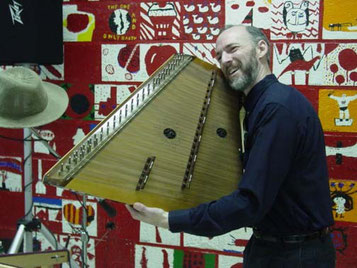Sam Says:
I believe that mountain dulcimers are among the world's coolest musical instruments. I want the general public to know them the way it knows guitars and pianos.
The mountain dulcimer is similar to a guitar, except for a few of the particulars:
- The fretboard sits on top of the instrument's body. Most players put their dulcimers on their laps, and strum them from above.
- Traditionally, dulcimers had only "diatonic" frets -- that is, each string basically could only play notes in the do-re-mi scale.
- They usually have only 3 or 4 strings.
For years, I thought mountain dulcimers were uninteresting -- after all, how much could you do with only 3 strings? But once I started playing it, I discovered how much fun it is -- and those supposed shortcomings actually turned out to be great strengths.
Dulcimer advantage: A guitar has 6 strings and you have 5 fingers. You're outnumbered. A dulcimer has 3 strings and you have 5 fingers. No excess strings to worry about. A beginner can pick out songs in minutes -- the "mistake notes" aren't there. Yet, 3 strings also is enough to play both melody and accompaniment at the same time.
Dulcimers come from traditional folk roots, but your dulcimer will be equally happy whether you play mountain music, Mozart, or Metallica on it.
It's common nowadays for dulcimers to have at least one or two "extra" frets. My "standard" setup for a dulcimer includes 0+, 1+, and 8+ frets (as well as 6+ and 13+ frets, which are nearly universal nowadays). This adds several useful notes and many useful chords, but is still simple enough to find the notes and chords without having to think. I also play fully chromatic and regular diatonic dulcimers.
Most people -- in fact, even most players -- don't recognize how much mountain dulcimers can do. In addition, they're easier to learn and easier to play than guitars. I believe there should be millions of kids begging their parents for a dulcimer for their next birthday.
I play mountain dulcimers by Ron Ewing, Folkcraft, Bear Meadow, Rod Matheson, McSpadden, George Haggerty, and Jim Fox -- plus a cardboard one from Backyard Music. There are many other very fine builders, such as Blue Lion, Jeremy Seeger, New Harmony, and others whose instruments I'm not familiar enough with.
A WORD ABOUT HAMMERED DULCIMERS
There's a second instrument, called the hammered dulcimer. If you're not familiar with it, see the photo. (Normally, it would be laying on a stand.) You hit the strings with pencil-sized drumsticks, so it's a bit like a piano or harpsichord, except that it's percussive. Mine has a 4-octave chromatic range and 95 strings.
Hammered dulcimers and mountain dulcimers are related like Lyndon Johnson and Magic Johnson.
I first got hooked on the sound of the hammered dulcimer in my teens, and after a decade of being a "groupie" and the token guitarist at dulcimer festivals, I finally bought one. They're fun to listen to, and they're incredible fun to play, but recently I've been more focused on the mountain dulcimer.

